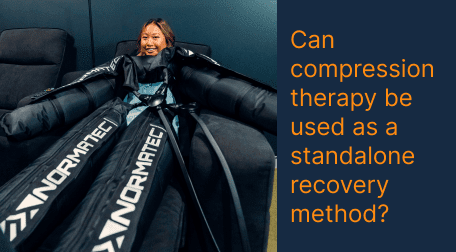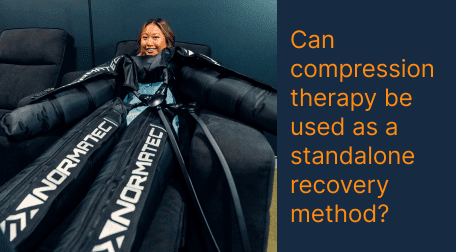Compression therapy

In the ever-evolving landscape of sports and fitness recovery, compression therapy has emerged as a popular method for enhancing recuperation and performance. Athletes, fitness enthusiasts, and even individuals recovering from surgery have turned to compression therapy to accelerate healing. This article delves into the question: Can compression therapy be used as a standalone recovery method?
What is compression therapy?
Compression therapy involves the use of specially designed garments to apply pressure to specific body parts, typically the limbs. This pressure aids in improving blood circulation, reducing swelling, and promoting faster recovery. It is widely used in various fields, including sports medicine, post-surgery recovery, and managing chronic conditions like lymphedema.
Benefits of Compression Therapy:
Improved Blood Circulation: Compression garments facilitate better blood flow, delivering oxygen and nutrients to muscles, which is crucial for recovery.
Reduced Swelling: The pressure applied by compression wear helps minimize swelling, particularly after intense physical activity or injury.
Enhanced Muscle Support: Compression sleeves provide support to muscles and joints, reducing the risk of injury and aiding in recovery.
Faster Lactic Acid Removal: Compression therapy assists in the removal of lactic acid, a byproduct of muscle exertion, helping to alleviate muscle soreness.
Is compression therapy a stand-alone method?
While compression therapy offers numerous benefits, it is essential to consider it as a complementary, rather than a standalone, recovery method. It can be integrated into a holistic approach to optimize results. Pairing compression therapy with proper nutrition, hydration, and other recovery techniques ensures a comprehensive and effective recovery plan.
Frequently Asked Questions:
Q1: Can compression therapy replace other recovery methods?
Compression therapy works best when combined with other recovery strategies. It complements methods like rest, hydration, and nutrition to provide a well-rounded approach to recovery.
Q2: How long should one use compression therapy for optimal results?
The duration of use depends on individual needs and the specific purpose of therapy. Consultation with a healthcare professional or sports medicine expert can help determine the appropriate duration for your case.
Q3: Is compression therapy only for athletes?
While athletes widely use compression therapy, it is suitable for anyone seeking enhanced recovery. Individuals recovering from surgery, managing chronic conditions, or dealing with everyday muscle fatigue can benefit from compression wear.
Conclusion:
In conclusion, compression therapy is a valuable tool in the realm of recovery, offering benefits such as improved circulation, reduced swelling, and enhanced muscle support. However, it should be viewed as part of a holistic recovery strategy, complementing rest, nutrition, and other essential practices. Whether you’re an athlete looking to optimize performance or an individual on the path to recovery, incorporating compression therapy into a comprehensive plan can unlock its full potential.
